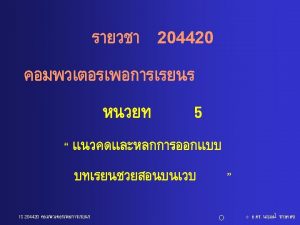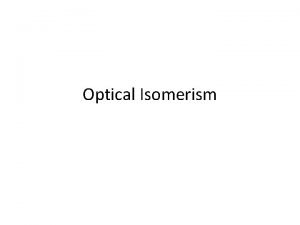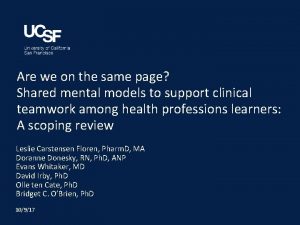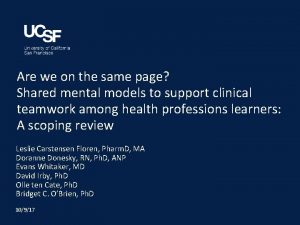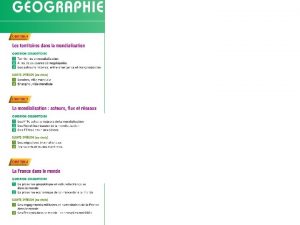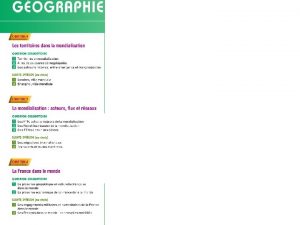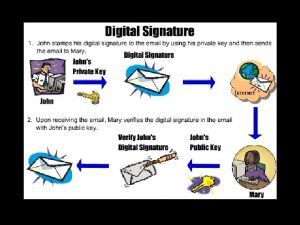Are we on the same page Shared mental
















- Slides: 16

Are we on the same page? Shared mental models to support clinical teamwork among health professions learners: A scoping review Leslie Carstensen Floren, Pharm. D, MA Doranne Donesky, RN, Ph. D, ANP Evans Whitaker, MD David Irby, Ph. D Olle ten Cate, Ph. D Bridget C. O’Brien, Ph. D 10/9/17

Session Learning Objectives By the end of the session, participants will be able to: • Define a “shared mental model” (SMM) • Describe qualitative and quantitative approaches to measuring SMMs • Discuss how we may apply the SMM construct to the design of educational interventions to support teamwork 2

Shared Mental Models & Teamwork Photo 1 § Team-based healthcare delivery • Struggle to “get on the same page” § Common understanding of tasks, roles = SMM • Organized Knowledge Shared X Team § SMMs support • Members’ ability to: predict, adjust, coordinate 3

Why Focus on SMMs in Health Professions Education? SMMs IMPROVE TEAMS INTERVENTIONS WORK • Processes • Performance • Facilitate SMM development Recognize, adapt, align MMs SMM of patient care Improved healthcare delivery 4

Study Purpose § To conduct a scoping review to: • Explore construct of SMMs in context of clinical teamwork among health professions learners • Identify gaps in current literature • Disseminate findings § Questions • How defined/applied? • Types of interventions? • Approaches to measurement? Photo 2 5

Methodological Framework 1. Identify Research Questions 2. Identify Relevant Studies Arksey & O’Malley, 2005; Levac et al. 2010 6 3. Study Selection 4. Chart Data 5. Collate, Summarize, Report Data

Results 1, 273 Records retrieved 7

Results: § SMM definitions ‒ SMM variably, infrequently defined (9/23) § Characterized as cognitive construct § Knowledge shared across members § Applications ‒ Hospital-based care (23/23) § High-intensity settings (14/23) ‒ Grad level MDs (21/23) 8 Image 1

Results: § Interventions ‒ Few interventions to foster SMM development (6/23) § Curricula, Team training, Tools • e. g. , checklist to develop SMM of Family-Centered Rounds § Measurement ‒ SMMs infrequently measured (7/23) • All included quantitative approaches • e. g. , surveys, concept maps, card sorting • One qualitative analysis 9

Discussion Recommendations/Actions • DEFINE: SMM to promote consistent usage • “An individually held, organized, cognitive representation of taskrelated knowledge and/or team-related knowledge held in common among health care professionals who must interact as a team in pursuit of common objectives for patient care. ” • DESIGN: use SMM construct to design team interventions • MEASURE: SMMs Directly or…. Indirectly 10

Acknowledgements Leslie Floren is funded by the Veterans Administration though the VA Advanced Fellowship Program in Health Professions Education Evaluation and Research

Image & Photo Credits • Photo 1 (Slide 2) ‒ https: //www. flickr. com/photos/dfid/16768375614/ [CC 2. 0] • Photo 2 (Slide 4) ‒ https: //upload. wikimedia. org/wikipedia/commons/1/13/US_Navy_071116 -N 1251 W 005_Hospital_corpsmen_assigned_to_the_Special_Medical_Operations_Respons e_Team_at_U. S. _Naval_Hospital_%28 USNH%29_Yokosuka%2 C_treat_a_simulate d_victim_during_a_bilateral_earthquake_response_drill. jpg; By U. S. Navy photo by Mass Communication Specialist 3 rd Class Matthew R. White [Public domain, via Wikimedia Commons] • Image 1 (Slide 8) ‒ https: //openclipart. org/pdf/169413/teamwork. pdf [Openclipart. org] 12

Background

How are SMMs characterized? • CONTENT DOMAINS • Taskwork • Goals & performance requirements related to team’s task What is a SMM? • Organized understanding / mental representation, shared across team members • CONTENT • Knowledge • Teamwork • Interpersonal interactions; team member K/S/A • PROPERTIES • Similarity • Accuracy • STRUCTURE • Organization of knowledge SMM 14 How are SMMs measured? • CONTENT • Survey instruments • Questionnaires • CONTENT + STRUCTURE • Paired comparisons • Card sorting • Concept mapping • Qualitative methods

Approach to Knowledge Synthesis • Scoping vs. Systematic Review ‒ Goal: comprehensive and inclusive exploration of SMM construct related to clinical teamwork in HPE context § Scoping methodology • Supports less restrictive inclusion criteria • Allows inclusion of information from many sources ‒ Few empirical studies of SMMs in HP trainees during initial exploration of construct Levac et al. , 2010; Colquhoun et al. , 2014 15

Discussion Attempted Application. . • Address GAPS: SMMs in learners in non-acute settings • Learner teams developing SMMS of care in Skilled Nursing Facility patients • Interviews focused on SMM of: • Falls Assessment (Task) • Professional roles (Team) • Did not reveal anything unexpected • Together for 2 weeks, saw one another’s roles “in action” • Perhaps less important in low acuity, synchronous care 16
 Insidan region jh
Insidan region jh Same time same place แปลว่า
Same time same place แปลว่า Cis trans vs e z
Cis trans vs e z Same place same passion
Same place same passion Similar figures have the same but not necessarily the same
Similar figures have the same but not necessarily the same Similar triangles and polygons
Similar triangles and polygons Apa format front page
Apa format front page Mental health jeopardy questions
Mental health jeopardy questions Mental health and mental illness chapter 20
Mental health and mental illness chapter 20 Một số thể thơ truyền thống
Một số thể thơ truyền thống Thế nào là sự mỏi cơ
Thế nào là sự mỏi cơ Trời xanh đây là của chúng ta thể thơ
Trời xanh đây là của chúng ta thể thơ Các số nguyên tố là gì
Các số nguyên tố là gì Tỉ lệ cơ thể trẻ em
Tỉ lệ cơ thể trẻ em Fecboak
Fecboak Các châu lục và đại dương trên thế giới
Các châu lục và đại dương trên thế giới Thế nào là hệ số cao nhất
Thế nào là hệ số cao nhất

